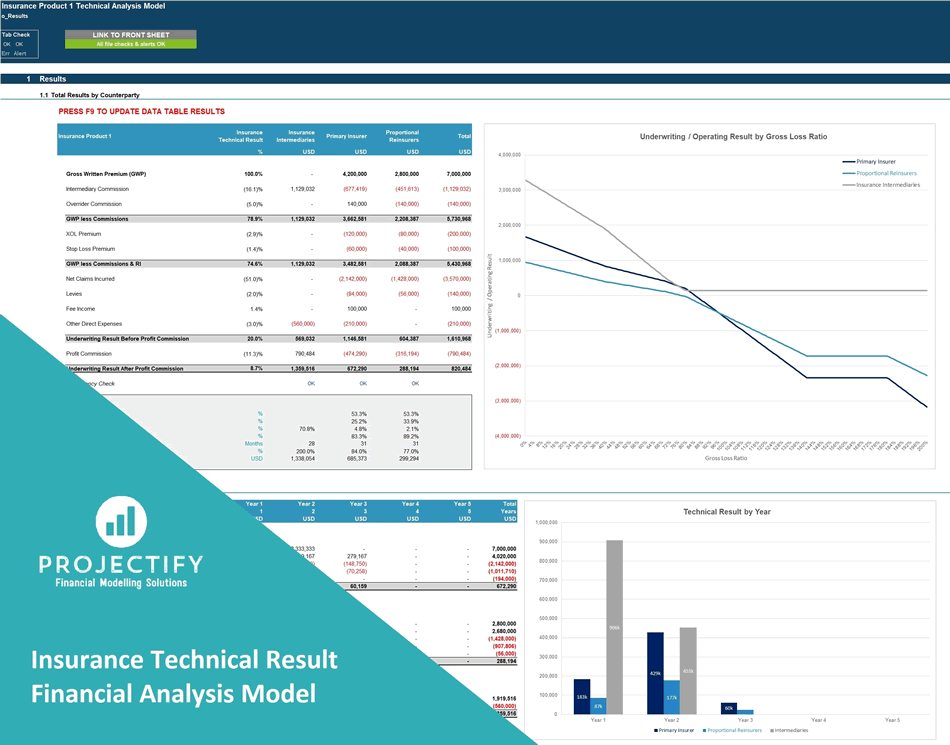Insurance Technical Analysis Financial Model (Excel XLSX)
Excel (XLSX) + Excel (XLSX)
VIDEO DEMO
BENEFITS OF THIS EXCEL DOCUMENT
- To understanding the technical results for a particular product or book of business and/or to understand the key aspects and workings of general insurance business and counterparties typically involved in writing an insurance book of business.
INSURANCE EXCEL DESCRIPTION
An Insurance Technical Analysis Financial Model is crucial for insurers. It assesses the technical aspects of insurance portfolios, aiding risk management, pricing strategies, and underwriting decisions. This model supports insurers in evaluating the performance of policies, analyzing claims data, and optimizing coverage offerings. Accurate technical analysis empowers insurers to adapt to market dynamics, enhance profitability, and ensure financial stability. It attracts reinsurers, supports regulatory compliance, and aligns insurance strategies with industry trends. This model is indispensable for both established insurers and startups, ensuring their financial viability, competitiveness, and ability to navigate the complexities of the insurance sector.
PURPOSE OF MODEL
User-friendly financial model to compute the underwriting result / operating result for all key counterparties (insurance intermediaries, primary insurer, proportional reinsurance) involved in writing an insurance product or book of business or to understand the key workings of insurance business.
The model analyses the premiums, commissions (including profit commission and sliding scale commission if applicable), reinsurance (quota share, XOL and stop loss), claims and operating expenses for a particular product or book of business from an income statement and cash flow perspective and computes the expected results for each counterparty across different gross loss ratios from 0-200%.
The model follows good practice financial modelling principles and includes instructions, checks and input validations.
KEY OUTPUTS
The key outputs include:
• Projected full underwriting portion of income statement and cash flow statement presented on a monthly and total basis
• Chart showing underwriting / operating result by gross loss ratio and counterparty
• Table showing underwriting / operating result and percentages by counterparty for the chosen gross loss ratio.
• Key financial ratios and metrics including loss ratio, expense ratio, combined ratio, Net Present Value (NPV) of cash flows and break-even loss ratios.
• Underwriting / operating result by year and counterparty
KEY INPUTS
• Product Name;
• Currency;
• Gross Written Premium (GWP) amount, period, coverage period and number of policies;
• Fee income per policy;
• Standard Commission percentage, sliding scale commission assumptions and profit commission assumptions;
• Expected loss ratio and average claims payment period;
• Proportional reinsurance percentage, overrider commission;
• XOL and Stop loss reinsurance costs and loss ratio limits;
• Levy and Expense ratios
• Cost of capital for NPV calculations.
MODEL STRUCTURE
The model comprises of 5 tabs split into input ('i_'), calculation (‘c_'), output ('o_') and system tabs. The tab to be populated by the user is the ‘i_assumptions' tab. The calculation tab uses the user-defined inputs to calculate and produce the projection outputs which are presented in the ‘o_Results' tab.
System tabs include:
• A 'Front Sheet' containing a disclaimer, instructions and contents;
• A checks dashboard containing a summary of checks by tab.
KEY FEATURES
Other key features of this model include the following:
• The model follows good practice financial modelling guidelines and includes instructions, checks and input validations to help ensure input fields are populated accurately;
• The model includes a 5 year monthly timeline for calculation of underwriting /operating results and cash flows.
• Apart from understanding the technical results for a particular product or book of business, the model can be used to understand the key aspects and workings of general insurance business and counterparties typically involved in writing an insurance book of business. This is a good resource for anyone wanting to learn more about general insurance business.
• The model includes sensitivity analysis to understand the underwriting/operating result by counterparty across different gross loss ratios.
• The model is not password protected and can be modified as required following download;
• The model is reviewed using specialised model audit software to help reduce risk of formula inconsistencies;
• The model includes a checks dashboard which summarises all the checks included in the various tabs making it easier to identify any errors.
Got a question about the product? Email us at support@flevy.com or ask the author directly by using the "Ask the Author a Question" form. If you cannot view the preview above this document description, go here to view the large preview instead.
Source: Best Practices in Insurance Excel: Insurance Technical Analysis Financial Model Excel (XLSX) Spreadsheet, Projectify








